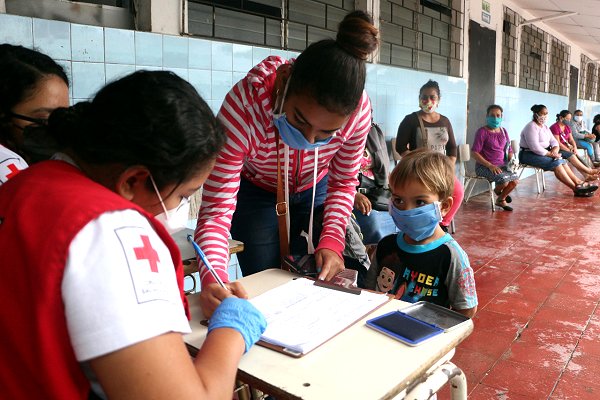
Acting early in a time of pandemic: the challenge of being ready for extreme weather during Covid-19

(A longer version of this article appeared last week as part of a series of blogs on epidemics on the forecast-based financing Anticipation Hub, including recommendations from recent Red Cross Red Crescent experience and discussions on acting early in a time of pandemic.)
Extreme events do not stop for a pandemic. This has been illustrated vividly by the impacts of Cyclone Harold in the Pacific, Tropical Storm Amanda in El Salvador (photo), the Zagreb earthquake and Super Cyclone Amphan in Bangladesh and India.
Many countries where humanitarian organizations implement anticipatory humanitarian action like forecast-based financing (FbF) are currently under lockdown or applying Covid-19 mitigation measures.
Vulnerable populations in these countries face the dual or even triple impacts of Covid-19 alongside floods, landslides, cyclones, droughts, earthquakes, locust swarms or conflict.
As countries enter seasons when extreme weather is likely, we face complex questions of how to balance ongoing work to mitigate Covid-19 with the need to protect people from approaching disasters.
Risk management cannot be put on hold
during Covid-19, even though organizations
are stretched to the limit
Is it possible to take early action while travel and other restrictions are in place, especially for hazards for which we have short lead-times?
What type of early actions are indispensable, even if implementation could increase the risk for Covid-19 infection?
How do we minimize risks to the health of volunteers working on early action?
The current situation means some rethinking, and National Societies are currently looking at their plans for early action, deciding which can be adapted and how.
In the past few weeks, practitioners of anticipation in various countries have reflected on these questions; in the Philippines, Vanuatu, and Bangladesh their decisions have already been put to the test.
When FbF managers were asked during an April meeting whether implementing early action would be possible, they responded that, “If restrictions are maintained and we don’t adapt the early action protocols, then no, we cannot act.”
Cooling centres
Since April, Cyclones Harold in the South Pacific and Amphan in Bangladesh have shown that with a hazard presenting immediate risks to life, governments will relax restrictions so that humanitarian actors such as the Red Cross can act to save lives and evacuate; that is good news.
However, in these cases the threat was imminent, the potential harm obvious, and early actions were primarily associated with evacuation. Whether governments will lift restrictions to allow for early action when the threat is less visible remains to be seen.
Jerome Faucet, FbF project manager for the German Red Cross in Vietnam, says: “The government is increasingly aware of the risks associated with heatwaves, they are very interested, and keen to engage with us on early actions.
“But heatwaves are not perceived to be as dangerous as other hazards yet. So I am not sure, if we have a warning of extreme heat this summer, if we can really act.”
Jerome’s team is currently considering how to operate cooling centres – a key early action in Vietnam – without increasing Covid-19 transmission.
For Typhoon Ambo in April, the Philippine Red Cross did not activate its EAP as the trigger was not reached by the agreed deadline, but the Red Cross has since adapted it to include additional Covid-19 measures, such as PPE for farmworkers who would carry out precautionary harvesting and additional transport to facilitate distancing.
The Philippine government has also adopted an interim humanitarian protocol, regulating how assistance can be provided under Covid-19 restrictions, but it is not yet adapted to early action.
In many cases, organizations and authorities are already stretched to the limit by Covid-19.
In the recent floods in Uganda and Zambia, for example, the National Societies managed to share early warning information but could not act early on a larger scale because of Covid-19 restrictions and consequent added workload.
Put to the test
Even before Cyclone Amphan, the Bangladesh Cyclone Preparedness Programme (CPP) issued adapted guidance that for example encourages staff and volunteers to avoid personal contact and instead use radio and digital media for spreading early warning messages; it was soon put to the test.
During the cyclone itself the CPP and the Bangladesh Red Crescent Society (BDRCS) used some 5,700 additional shelters – schools and government buildings – to reduce density of evacuees.
Disinfection gels, soap, and water were available in the shelters, and handwashing was encouraged. Volunteers received PPE and beneficiaries were encouraged to cover their faces; suspected Covid-19 cases were accommodated in separate buildings.
Despite restrictions, the BDRCS managed to assist nearly 36,000 evacuees, providing water and food and helping the most vulnerable families get livestock and belongings to safety.
There is no reliable data yet as to whether the evacuation of more than 2 million people led to an increase in Covid-19 infections, which have risen since the cyclone, but mostly in the capital, Dhaka, where no evacuations took place.
Our risk management work cannot be put on hold during Covid-19, even though organizations are stretched to the limit: it is vital to start thinking now about what can be done if we receive a forecast of an extreme event.
Tropical Storm Amanda in El Salvador triggered a humanitarian cash grant from the IFRC’s DREF for the National Society of a quarter of a million dollars. The first named storm of the Pacific 2020 season made landfall on 31 May in Guatemala and El Salvador, with the latter then reporting just over 50 deaths from Covid-19. Now the threat of vector-borne diseases such as dengue, chikungunya or Zika is a growing additional concern as the rainy season begins. (Photo: El Salvador Red Cross via IFRC Americas.)